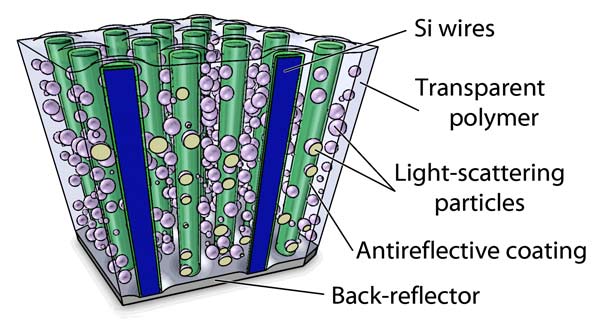Material Traps Light on the Cheap
A new photovoltaic material performs as well as the one found in today’s best solar cells, but promises to be significantly cheaper. The material, created by researchers at Caltech, consists of a flexible array of light-absorbing silicon microwires and light-reflecting metal nanoparticles embedded in a polymer.

Computational models suggest that the material could be used to make solar cells that would convert 15 to 20 percent of the energy in sunlight into electricity–on par with existing high-performance silicon cells. But the material would require just 1 percent of the materials used today, potentially leading to a dramatic decrease in costs. The researchers were led by Harry Atwater, professor of applied physics and materials science at Caltech.
The key to the new material’s performance is its ability to trap light. The longer a photon bounces around inside the active part of any solar cell, the greater the chance it will dislodge an electron. All high-performance solar cells have antireflective coatings that help trap light. But these cells use require far more silicon and must be sawed from wafers, a wasteful process.
“The promise of light trapping has always been that you could use less silicon and bring the costs down, but it’s been difficult to implement,” says Eli Yablanovitch, professor of electrical engineering at the University of California, Berkeley, who was not involved with the research.
Many groups have turned to structures such as nanowires and microwires in an effort to solve this problem. The Caltech group’s photovoltaic material, which uses silicon microwires, demonstrates a new level of performance largely due to the addition of reflective nanoparticles.
Atwater’s group grew arrays of silicon microwires from a gas on the surface of a reusable template. The template dictates how thickly the forest of wires will grow, and the diameter of each wire. The arrays are arranged sparsely, and without further treatment, make a poor solar material. But the wires are treated with an antireflective coating and coated in a rubbery polymer mixed with highly reflective alumina nanoparticles. Once the polymer sets, the entire thing can be peeled off like a sticker. Over 90 percent of the resulting material is composed of the cheap polymer, and the template can be used again and again.
“These materials are pliable, but they have the properties of a silicon wafer,” says Atwater. When light hits the composite solar mats, it bounces around, reflecting off the alumina particles until it can be absorbed by a microwire.

Even though the microwire arrays are quite sparse, the reflective particles ensure that very little light escapes before it’s absorbed. The Caltech group has not yet published details of the material’s performance as part of a solar cell, but the composite has demonstrated very good numbers for light absorbance and electron carrier collection.
“There are three things a solar cell has to do: it has to absorb the light, collect all the [electrons], and generate power,” says Atwater. The material can absorb 85 percent of the sunlight that hits it, and 95 percent of the photons in this light will generate an electron. Until the results are published, the Caltech group won’t disclose their power generation results.
“What’s exciting is, you can use a lot less material to make a solar cell–two orders of magnitude less,” says Yi Cui, professor of materials science at Stanford University. This will do more than just lower the material’s costs. “Once you use less material for deposition, your manufacturing line is shorter,” Cui explains. This has two business implications: it should take less capital investment to build the factories needed to make the cells, and it should be possible to produce them at a faster rate.
Atwater’s group is now working on making the photovoltaic material over a larger area and incorporating it into prototype solar cells. The results published so far come from proof of concept experiments using square centimeters of the material. “We have to do the normal unglamorous engineering: making low-resistance electrical contacts, and making large areas, hundreds of square centimeters,” says Atwater. He adds that although the material is put together in a novel way, it can be made using a combination of techniques that are well established and scalable.
Keep Reading
Most Popular
Large language models can do jaw-dropping things. But nobody knows exactly why.
And that's a problem. Figuring it out is one of the biggest scientific puzzles of our time and a crucial step towards controlling more powerful future models.
The problem with plug-in hybrids? Their drivers.
Plug-in hybrids are often sold as a transition to EVs, but new data from Europe shows we’re still underestimating the emissions they produce.
Google DeepMind’s new generative model makes Super Mario–like games from scratch
Genie learns how to control games by watching hours and hours of video. It could help train next-gen robots too.
How scientists traced a mysterious covid case back to six toilets
When wastewater surveillance turns into a hunt for a single infected individual, the ethics get tricky.
Stay connected
Get the latest updates from
MIT Technology Review
Discover special offers, top stories, upcoming events, and more.